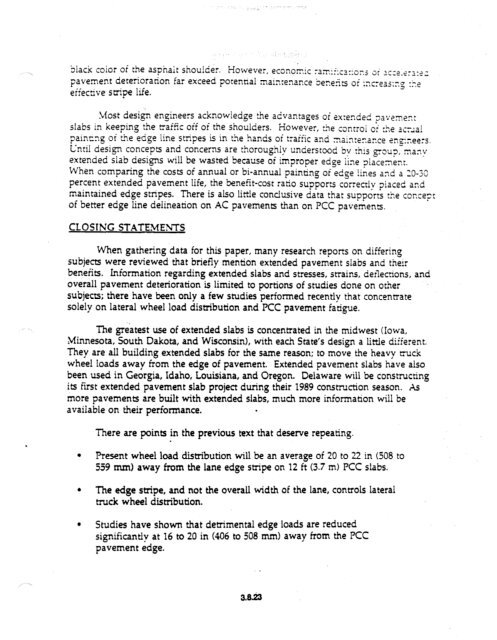chapter 3 rigid pavement - DOT On-Line Publications - Department ...
chapter 3 rigid pavement - DOT On-Line Publications - Department ...
chapter 3 rigid pavement - DOT On-Line Publications - Department ...
You also want an ePaper? Increase the reach of your titles
YUMPU automatically turns print PDFs into web optimized ePapers that Google loves.
lack coior of the asuhait shoulder. However, economic ram:i:c~::on,j oi zc;2,2r-- s.?- -<br />
<strong>pavement</strong> deteriorahon far exceed potential maintenarce bene5;its or :r,creas;r.g :+.e<br />
effective stripe life.<br />
-Most design engineers acknowledge the advantages or’ extended zav?xez:<br />
slabs in keeping the traffic off of the shoulders. However, :h.e controi o; :he a!crAal<br />
paincng oi the edge line stripes is in the hands of traffic and - ..,aiz-iter,ar.ce engineers.<br />
Until design concepts and concerns are thoroughiy understood bv this grou?, many<br />
extended slab designs will be wasted because of improper edge lme piacemen:.<br />
When comparing the costs of annual or bi-annual painting of edge lines and a 20-X<br />
percent extended <strong>pavement</strong> life, the benefit-cost ratio supports correctly piaced and<br />
maintained edge stripes. There is also little conclusive data that supports the cor.ceFt<br />
of better edge Iine delineation on AC <strong>pavement</strong>s than on KC <strong>pavement</strong>s.<br />
CLOSING STATEMEVI-S<br />
When gathering data for this paper, many research reports on differing<br />
subjects were reviewed that briefly mention extended <strong>pavement</strong> slabs and their<br />
benefits. information regarding extended slabs and stresses, strains, deflections, and<br />
overall <strong>pavement</strong> deterioration is limited to portions of studies done on other<br />
subjects; there have been only a few studies performed recently that concentrate<br />
solely on lateral wheel load distribution and KC <strong>pavement</strong> fatigue.<br />
‘_<br />
The greatest use of extended slabs is concentrated in the midwest (Iowa,<br />
-Minnesota, South Dakota, and Wisconsin), with each State’s design a little different.<br />
They are all building extended slabs for the same reason; to move the heavy truck<br />
wheel loads away from the edge of <strong>pavement</strong>. Extended <strong>pavement</strong> slabs have also<br />
been used in Georgia, Idaho, Louisiana, and Oregon. Deiaware wiil be constructing<br />
its first extended <strong>pavement</strong> slab project during their 1989 construction season. &<br />
more <strong>pavement</strong>s are built with extended slabs, much more information will be<br />
avaiiable on their performance.<br />
.<br />
There are points in the previous text that deserve repeating.<br />
.<br />
l Resent wheel load distribution will be an average of 20 to 22 in (508 to<br />
559 mm) away from the lane edge stripe on 12 ft (3.7 m) PCC slabs.<br />
l The edge stripe, and not the overall width of the lane, controls lateral<br />
truck wheel distribution.<br />
l Studies have shown that detrimental edge loads are reduced<br />
significantly at 26 to 20 in (406 to 508 mm> away from the KC<br />
<strong>pavement</strong> edge.<br />
3.823
















